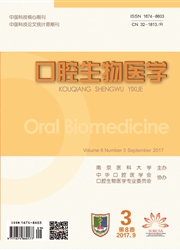

 中文摘要:
中文摘要:
目的:采用生物信息学方法对两名骨硬化症患者的电压门控氯通道7基因(CLCN7)突变位点进行分析,比较突变对蛋白结构、理化性质等方面的影响,预测突变可能对疾病发生产生的作用。方法:提取两例骨硬化症患者及家庭成员外周血基因组DNA,PCR扩增CLCN7基因并进行序列分析;采用NCBI在线搜索、PolyPhen-2数据库、DNAStar软件、SWISS MODEL等多种手段对突变基因编码的蛋白质进行多方面预测。结果:病例1为中间型常染色体隐性遗传骨硬化症,基因测序表明其CLCN7基因16号外显子产生了c.1409 C〉T纯合突变,所编码氨基酸由脯氨酸变为亮氨酸;病例2为Ⅱ型常染色体显性遗传骨硬化症,其10号外显子发生了c.856 C〉T杂合突变,精氨酸变为色氨酸。两个突变位点在多个物种均表现出高度同源性,突变可导致CLC-7蛋白二级结构发生变化,从而改变蛋白质立体结构、理化特性等方面的特征。结论:多种生物信息学分析表明CLCN7基因的c.856 C〉T和c.1409 C〉T可改变蛋白的分子结构和功能,表现为有害类型的突变,可能导致骨硬化症的发生。
 英文摘要:
英文摘要:
Objective To analyze two mutations in voltage gated chloride channel 7 gene ( CLCN7) of two osteopetrosis patients u-sing bioinlor'matic methods,and compare the effects of mutations on protein structure and physicochemical characteristics,so as to pre-dict the damaging effect of the mutations on the disease development. Methods : Genomic DNA were collected from peripheral blood of two osteopetrosis patients and their family members. CLCN7 gene was PCR amplified and sequenced. NCBI website, PolyPhen-2, DNAStar,SWISS MODEL were used to analyze the effect of the mutated genes. Results: Case 1 was diagnosed as intermediate autoso-mal recessive osteopetrosis (IARO),and his CLCN7 gene showed a de novo homozygous mutation c.1409 C〉T in exon 16,which re-sulted in a residue substitution from proline to leucine (c.1409 C〉T; p.Pro470Leu). Case 2 was diagnosed as autosomal dominant os-teopetrosis type n (AD〇n ) . The sequence analysis revealed a heterozygous mutation c.856 C〉T in exon 10 of CLCN7 gene, which resulted in arginine to tryptophan residue substitution (c.856 C〉T; p.Arg286Trp). Both of the mutations are located in highly con-served domain among different species. The mutations cause the changes in the secondary structure, tertiary structure and physicochem-ical properties and so on. Conclusions: Multiple bioinformatic analyses indicate that the mutations in CLCN7 gene (c.1409 C〉T and c. 856 C〉T) can change the molecule structure and affect biological function of ClC-7,which shows a damaging effect and might be the key of disease development in the patients.
 同期刊论文项目
同期刊论文项目
 同项目期刊论文
同项目期刊论文
 期刊信息
期刊信息
